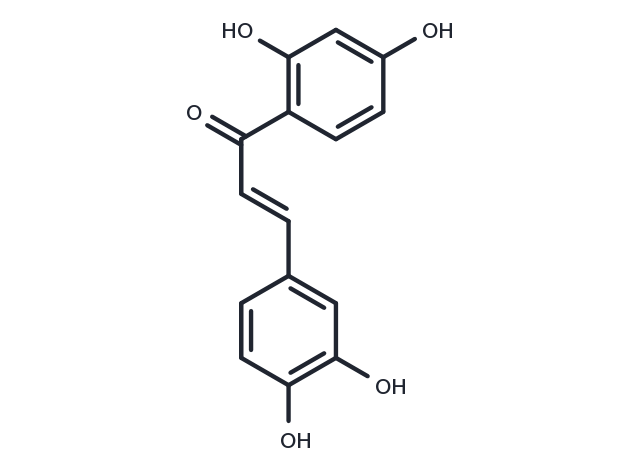Powder: -20°C for 3 years | In solvent: -80°C for 1 year
Butein (2’,3,4,4’-tetrahydroxy Chalcone), a plant polyphenol, is isolated from Rhus verniciflua. It can inhibit the activation of protein tyrosine kinase, NF-κB and STAT3, and also can inhibit EGFR.

| パッケージサイズ | 在庫状況 | 単価(税別) |
|---|---|---|
| 1 mg | 在庫あり | ¥ 8,500 |
| 2 mg | 在庫あり | ¥ 12,000 |
| 5 mg | 在庫あり | ¥ 18,500 |
| 10 mg | 在庫あり | ¥ 25,000 |
| 25 mg | 在庫あり | ¥ 52,000 |
| 50 mg | お問い合わせ | ¥ 83,500 |
| 100 mg | お問い合わせ | ¥ 133,000 |
| 1 mL * 10 mM (in DMSO) | 在庫あり | ¥ 18,500 |
| 説明 | Butein (2’,3,4,4’-tetrahydroxy Chalcone), a plant polyphenol, is isolated from Rhus verniciflua. It can inhibit the activation of protein tyrosine kinase, NF-κB and STAT3, and also can inhibit EGFR. |
| ターゲット&IC50 | p60c-src:65 μM, EGF:65 μM |
| In vitro | Butein inhibits the epidermal growth factor (EGF)-stimulated auto-phosphotyrosine level of EGF receptor in HepG2 cells, and also inhibits tyrosine-specific protein kinase activities of EGF receptor and p60c-src with IC50 of 65 μM in vitro. The inhibition is competitive to ATP and non-competitive to the phosphate acceptor, poly (Glu, Ala, Tyr) 6:3:1 for EGF receptor tyrosine kinase. In contrast, Butein non-significantly inhibits the activities of serine- and threonine-specific protein kinases such as PKC or PKA. [1] Butein inhibits Nuclear Factor(NF)-κB and NF-κB-regulated gene expression through direct inhibition of IκBα Kinase β on Cysteine 179 Residue. [2] Butein (10 μM) inhibits over 90% iNOS and COX-2 expression, as well as nitrite and TNF-α production in LPS-stimulated RAW 264.7 cells. Butein (10 μM) inhibits LPS-induced DNA binding activity of NF-κB, which is mediated through inhibition of the degradation of inhibitory factor-κB and phosphorylation of Erk1/2 MAP kinase, as well as increases binding of the osteopontin a vb3 integrin receptor. [3] Butein (20 μM) treatment induces morphologic changes of bladder cancer cells BLS(M) from elongated morphology to rounded epithelial-like cells, accompanied by downregulation of vimentin, and gaining of E-cadherin compared to untreated control cells, indicating the reversal of mesenchymal-like phenotype. Butein (20 μM) suppresses motility and invasion capacity of BLS(M) cells, and reverts EMT-like phenotype induced by TNF-α, through the ERK1/2 and NF-κB signaling pathways. [4] |
| In vivo | Butein at 2 mg/kg induces significant inhibition of hepatocellular tumor growth compared with the corn oil-treated controls. At necropsy on day 22 after initial treatment, there is more than 2-fold decrease in tumor growth in the Butein-treated group (mean relativetumor burden, 3.90) compared with the control group (8.46), associated with reduced constitutive p-STAT3 (9% vs 81% of vehicle group), Bcl-2 levels (26% vs 96% of vehicle group), and increased caspase-3 level (98% vs 21% of vehicle group) in HCC tumor tissues. [5] Butein shows antifibrogenic activity. Butein (25 mg/kg/day) reduces serum AST and ALT activation to 35% and 69%, respectively, of control CCl4-induced rat levels. Butein (25 mg/kg/day) reduces liver hydroxyproline contents and TBAR4 concentration to 54% and 54%, respectively. α1(I) collagen and TIMP-1 expression in Butein-treated rats is 28% and 20.3% compared with the values for the respective CCl4-treated control. [7] |
| 細胞研究 | The cells (5× 103/mL) are incubated in triplicate in a 96-well plate in the presence or absence of indicated concentration of Butein in a final volume of 0.2 mL for different time intervals at 37 ℃. Thereafter, 20 μL MTT solution (5 mg/mL in PBS) is added to each well. After a 2-hour incubation at 37 ℃, 0.1 mL lysis buffer (20% SDS, 50% dimethylformamide) is added, incubation is continued overnight at 37 ℃, and then the optical density at 570 nm is measured by plate reader. (Only for Reference) |
| 植物由来 |
| 別名 | 2’,3,4,4’-tetrahydroxy Chalcone |
| 分子量 | 272.25 |
| 分子式 | C15H12O5 |
| CAS No. | 487-52-5 |
Powder: -20°C for 3 years | In solvent: -80°C for 1 year
DMSO: 51 mg/mL (187.3 mM)
Ethanol: 51 mg/mL (187.3 mM)
H2O: < 1 mg/mL (insoluble or slightly soluble)
You can also refer to dose conversion for different animals. 詳細
bottom
Please see Inhibitor Handling Instructions for more frequently ask questions. Topics include: how to prepare stock solutions, how to store products, and cautions on cell-based assays & animal experiments, etc.
Butein 487-52-5 Angiogenesis Apoptosis Autophagy JAK/STAT signaling Metabolism Others Tyrosine Kinase/Adaptors EGFR PDE PDE4 Epidermal growth factor receptor Inhibitor MAPK 2’,3,4,4’-tetrahydroxy Chalcone ErbB-1 FoxO3a inhibit cell SIRT1 Phosphodiesterase (PDE) ERK PKB AKT HeLa HER1 p38 HepG2 inhibitor
